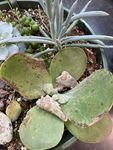Powdery Mildew on Succulents Is Not What You Would Expect
←
→
Page content transcription
If your browser does not render page correctly, please read the page content below
Jan Byrne Mary Hausbeck Roberto G. Lopez
byrnejm@msu.edu hausbec1@msu.edu rglopez@msu.edu
Volume 10 Number 3 January 2021
Powdery Mildew on Succulents 2021 Sponsors
Is Not What You Would Expect
Powdery mildew on succulents can appear more like sun
scald or edema. In this alert, we will show you what to
look for and the fungicides labeled to treat powdery
mildew. Remember, when in doubt, submit a sample to a
diagnostic lab for confirmation.
From 1998 to 2019, cacti and succulent production for
containers, crafts, and floral arrangements has increased by
over 75% ($78.6 million USD) and is expected to continue to
increase due to continued consumer interest in house plants. In
terms of production challenges, the biggest complaint from
greenhouse growers is their slow growth and limited production
and pest management information. Generally, succulents have
few pest or physiological issues. The most common include:
mealy bugs, scale, powdery mildew, edema, and sun scald.
Signs of powdery mildew
infection are fairly easy to
recognize when the
pathogen is advanced or Reprint with permission from the
severe on most crops (Fig. author(s) of this e-GRO Alert.
1). This includes, white-
grey, talcum-like colonies
of fungal growth on the
upper leaves of most
susceptible plants.
Figure 1. Severe powdery mildew infection
on peony.
www.e-gro.org
1e-GRO Alert - 2021 Powdery Mildew on Succulents
The infection usually starts small, but under
certain environmental conditions, can rapidly
blight and damage leaves, stems, and
flowers. The white, powdery or fluffy
appearance is created by conidia (spores)
that give this fungus its name (Fig. 1). In
Table 1, we identify the most common
greenhouse crops that are susceptible to
powdery mildew fungi.
Identifying the disease can be difficult on
some crops, as it mimics symptoms of sun
scald (Fig. 2), physiological disorders (Fig. 3), Figure 2. Sun scald on this succulent mixed container that
was moved from an indoor to outdoor retail display.
or nutrient deficiencies (yellow or purple [Photo: Anthony Soster, Michigan State University (MSU)]
leaves). Withering and death of leaves in the
center of the crop or stunted plant growth
are other symptoms.
Unfortunately, the genera and species of
fungi that cause powdery mildew are diverse
and highly mobile; they can be dispersed long
distances by wind. However, unlike most
other fungal foliar diseases affecting
greenhouse crops, they do not need free
water to germinate and infect their hosts. Figure 3. Echeveria exhibiting symptom of edema. (Photo:
Anthony Soster)
Relative humidity greater than 90% and
temperatures between 65 to 85 ºF can
prompt epidemics in the greenhouse and in
the landscape. Therefore, you should always
scout your crops for powdery mildew and
other pathogen symptoms, but be especially
vigilant during the spring and fall when the
weather often favors this disease.
In succulents, light and dark brown scabby
Figure 4. Botrytis on Aeonium. (Photo: Anthony Soster, MSU)
spots, lesions or bumps are an indication of
powdery mildew infection (Figs. 6, 7, 8, and
9). Unfortunately, these are the same
symptoms that we often associate with sun
scald and edema on succulents (Figs. 2 and
3). Additionally, Botrytis on Aeonium (Fig. 4)
and Alternaria and Cladosporium infection on
Kalanchoe can resemble powdery mildew
(Fig. 5). Succulents in the genus Kalanchoe
are the most susceptible to powdery mildew
Figure 5. Alternaria and Cladosporium infection on
infection. Given that succulents are slow kalanchoe ‘Villosa’ that resembles a powdery mildew
growing and desired for their foliage, infection. (Photo: Roberto Lopez, MSU)
severely diseased plants should be discarded.
www.e-gro.org 2e-GRO Alert - 2021 Powdery Mildew on Succulents
Figure 6. Scab-like lesions on Echeveria from a Figure 7. Close up of Kalanchoe thyrsiflora
powdery mildew infection. (Photo: Roberto ‘Flapjacks’ leaves with non-typical powdery
Lopez, MSU) mildew symptoms. (Photo: Roberto Lopez, MSU)
Figure 8. Kalanchoe thyrsiflora ‘Flapjacks’ is Figure 9.Crassula with powdery mildew
the only plant that has signs of powdery mildew symptoms. (Photo: Garrett Owen, UK)
infection in this succulent combination planter.
(Photo: Erin Hill, MSU) Bedding plants Potted crops Perennials
begonia African violets aster
Table 1. Greenhouse crops calibrachoa chrysanthemums bee balm
that are susceptible to dahlia gerbera coreopsis
powdery mildew.
pansy kalanchoe peony
petunia poinsettia phlox
snapdragon roses rudbeckia
verbena sunflower scabiosa
zinnia sedum
www.e-gro.org 3e-GRO Alert - 2021 Powdery Mildew on Succulents
Growing powdery mildew susceptible Note that all the products in the “A Team”
ornamental crops can be a challenge. have the FRAC code 3, but have different
However, fungicides can be helpful if active ingredients (myclobutanil,
effective products are chosen and applied metconazole and triflumizole). These
early. The Fungicide Resistance Action active ingredients all act on the powdery
Committee (FRAC) assigns alphanumeric mildew fungus in a similar way; to lessen
codes that are based on the mode of action the risk of the fungus developing
of the active ingredient. When utilizing resistance, relying on them is not
fungicides, always rotate among products recommended. Therefore, you should
with different FRAC codes to reduce the alternate among the products in the “A
possibility of resistance developing in the and A-/B Teams” as they have different
powdery mildew pathogen. FRAC codes. It’s important to test these
products for phytotoxicity on a small group
Multiple trials conducted at MSU were of succulents before treating the entire
conducted to create Table 2. It contains “A” crop as they are more susceptible than
and “A-/B” Team recommended fungicides other plants. Do not mix the fungicides
for powdery mildew on ornamentals. with a surfactant, insecticides, or fertilizer
Ornamental products listed in the “A Team” when treating succulents as this could
table consistently provide effective control. increase the risk of phytotoxicity.
Table 2. MSU tested fungicides to control powdery mildew on ornamentals.
Powdery Mildew A Team
Product Active ingredient FRAC code
Eagle EW/WP myclobutanil 3
Terraguard SC triflumizole 3
Tourney metconazole 3
Powdery Mildew A-/B Team
Product Active ingredient FRAC code
Compass O trifloxystrobin 11
Heritage azoxystrobin 11
azoxystrobin/
Mural 11/7
benzovindiflupyr
fluxapyroxad/
Orkestra 7/11
pyraclostrobin
pyraclostrobin/
Pageant Intrinsic 11/7
boscalid
Palladium WDG fludioxonil/ cyprodinil 9/12
Strike Triadimefon 3
trifloxystrobin/
Strike Plus 11/3
triadimefon
www.e-gro.org 4e-GRO Alert - 2021
e-GRO Alert Cooperating Universities
www.e-gro.org
CONTRIBUTORS
Dr. Nora Catlin
FloricultureSpecialist
Cornell Cooperative Extension
Suffolk County
nora.catlin@cornell.edu
Dr. Chris Currey
Assistant Professor of Floriculture
Iowa State University
ccurrey@iastate.edu
Dr. Ryan Dickson
Greenhouse Horticulture and
Controlled-Environment Agriculture
University of Arkansas
ryand@uark.edu
Thomas Ford
Commercial HorticultureEducator
Penn State Extension
tgf2@psu.edu
Dan Gilrein
Entomology Specialist
Cornell Cooperative Extension
Suffolk County
dog1@cornell.edu
Dr. Joyce Latimer
Floriculture Extension & Research
Virginia Tech
jlatime@vt.edu
Heidi Lindberg
Floriculture Extension Educator
Michigan State University
wolleage@anr.msu.edu
Dr. Roberto Lopez
Floriculture Extension & Research
Michigan State University
rglopez@msu.edu
Dr. Neil Mattson
Greenhouse Research & Extension
Cornell University
neil.mattson@cornell.edu
Dr. W. Garrett Owen
Greenhouse Extension & Research
University of Kentucky
wgowen@uky.edu
Dr. Rosa E. Raudales
Greenhouse Extension Specialist
University of Connecticut
rosa.raudales@uconn.edu
In cooperation with our local and state greenhouse organizations
Dr. Beth Scheckelhoff
Extension Educator – GreenhouseSystems
The Ohio State University
scheckelhoff.11@osu.edu
Dr. Ariana Torres-Bravo
Horticulture/ Ag. Economics
PurdueUniversity
torres2@purdue.edu
Dr. Brian Whipker
Floriculture Extension & Research
NC State University
bwhipker@ncsu.edu
Dr. Jean Williams-Woodward
Ornamental Extension Plant Pathologist
University of Georgia
jwoodwar@uga.edu
Copyright © 2021
Where trade names, proprietary products, or specific
equipment are listed, no discrimination is intended and
no endorsement, guarantee or warranty is implied by
the authors, universities or associations.
www.e-gro.org 5You can also read



























































